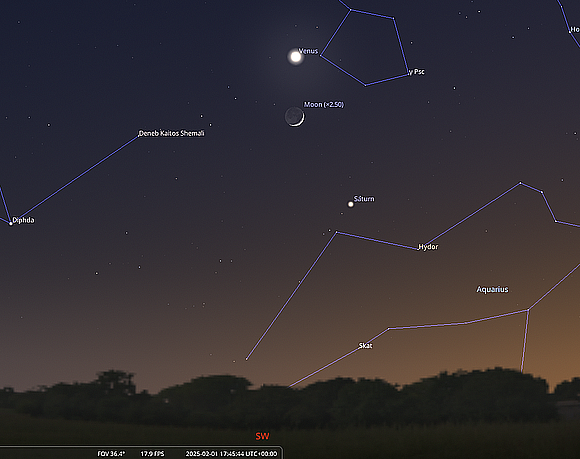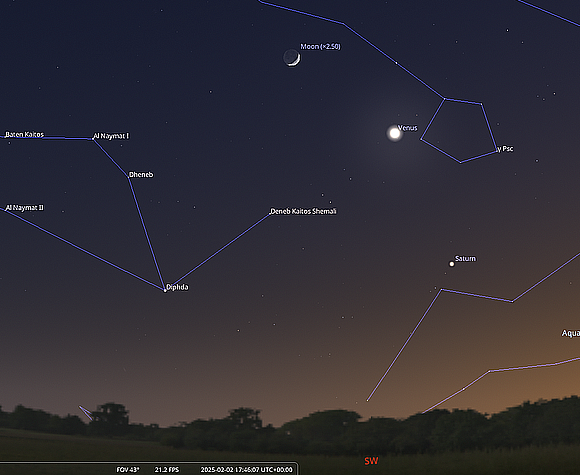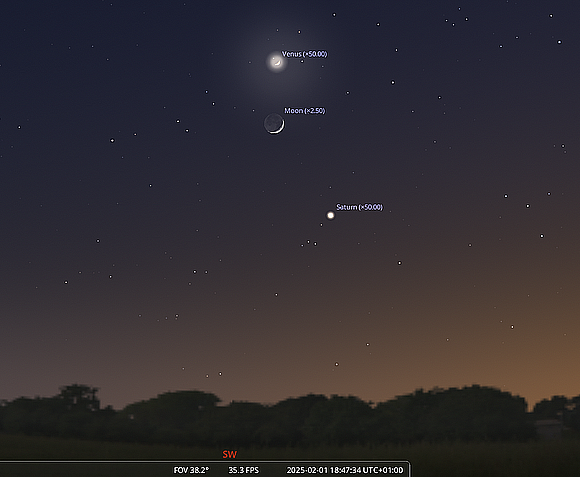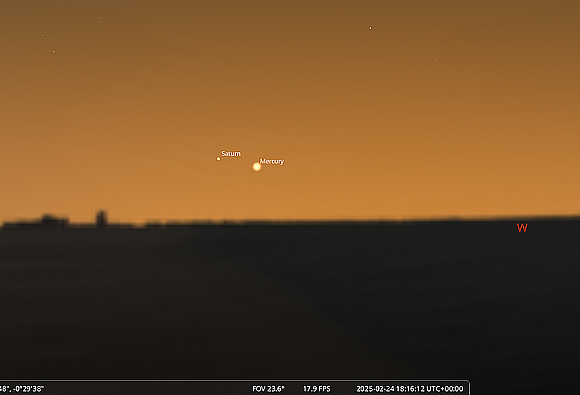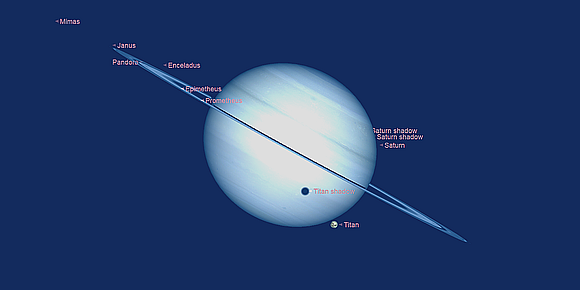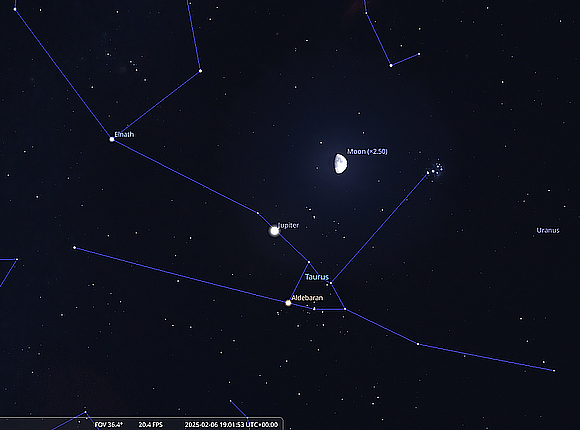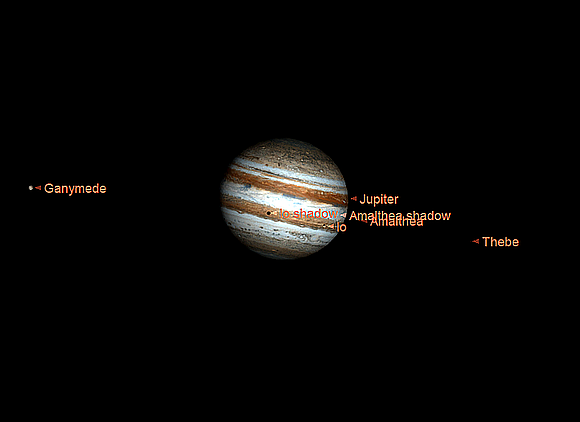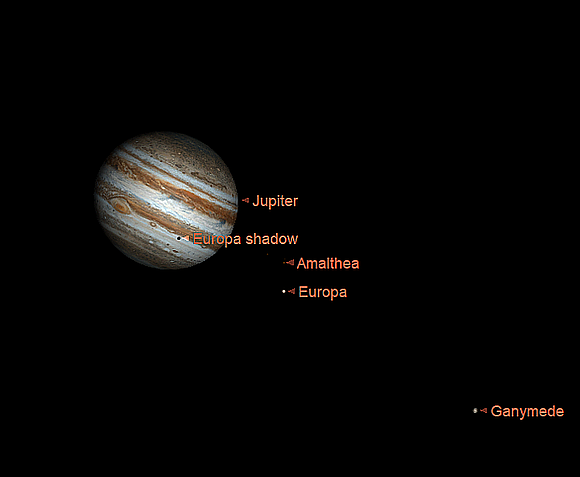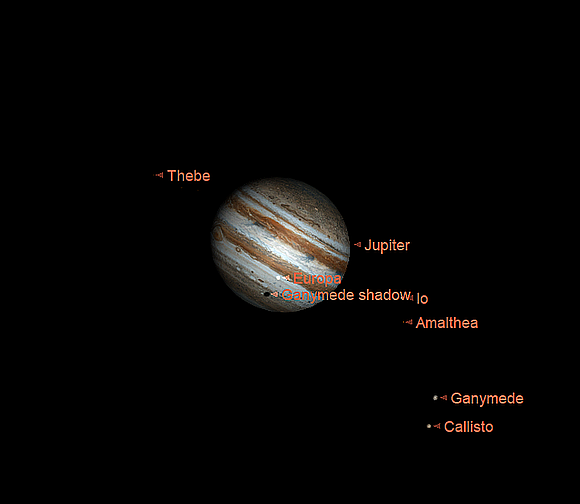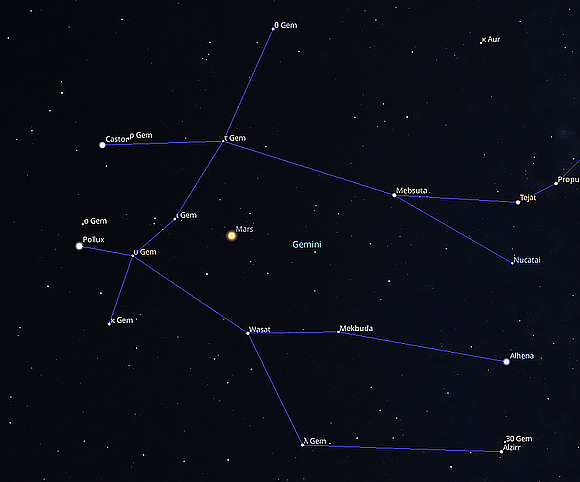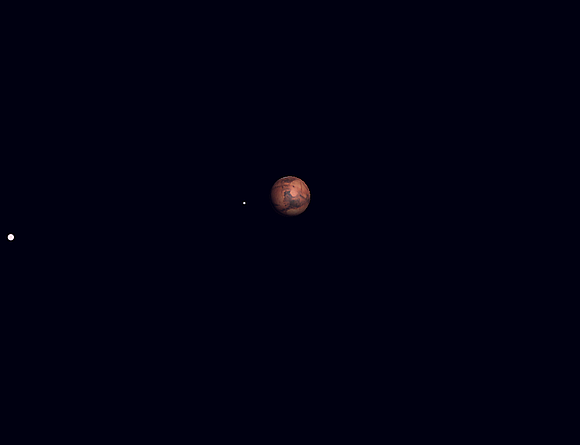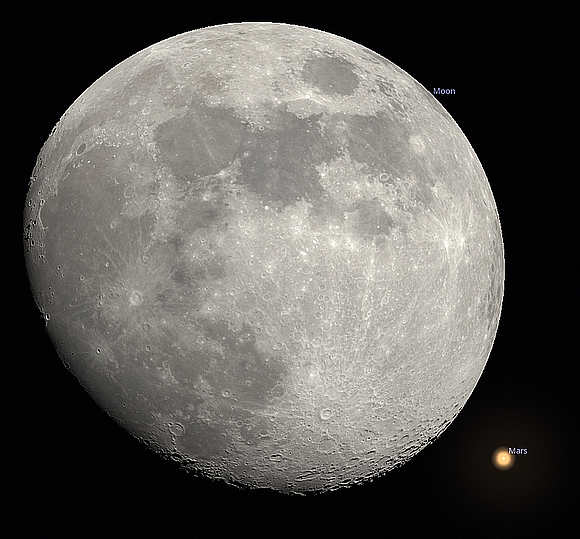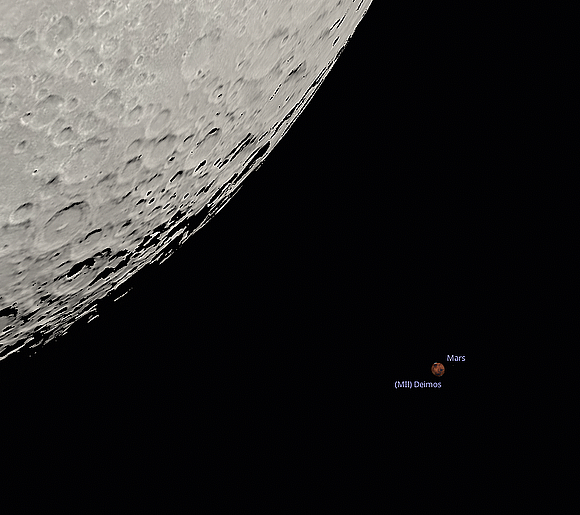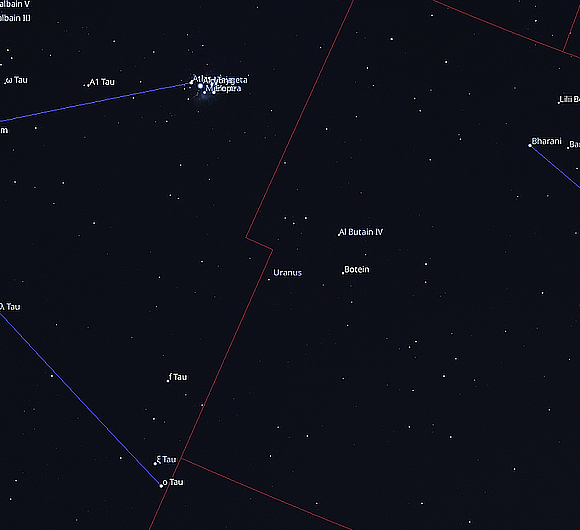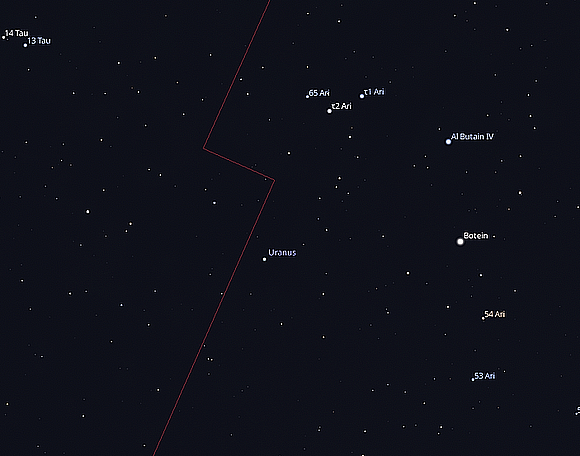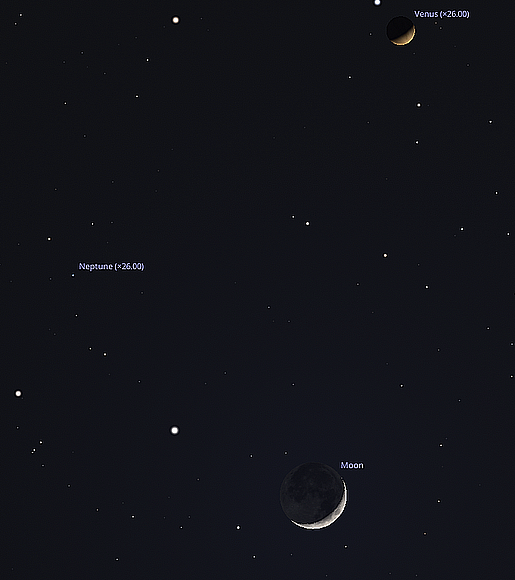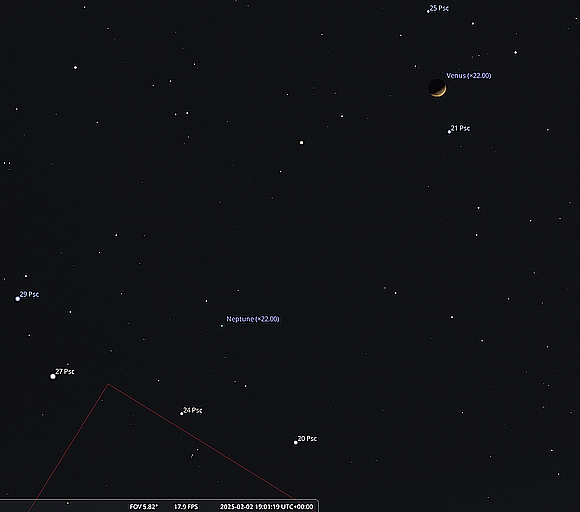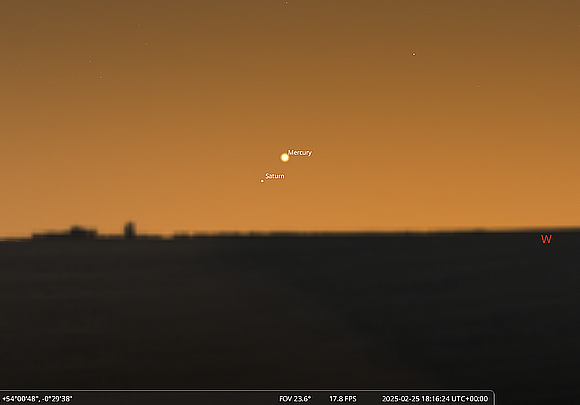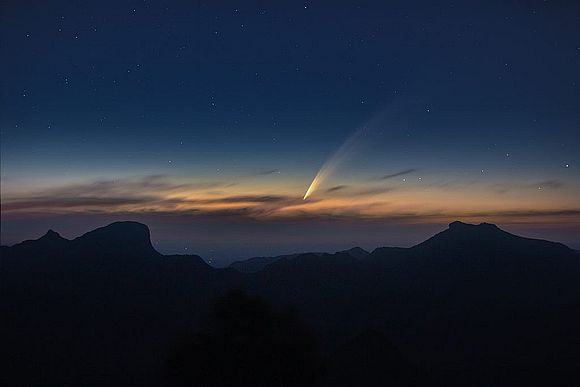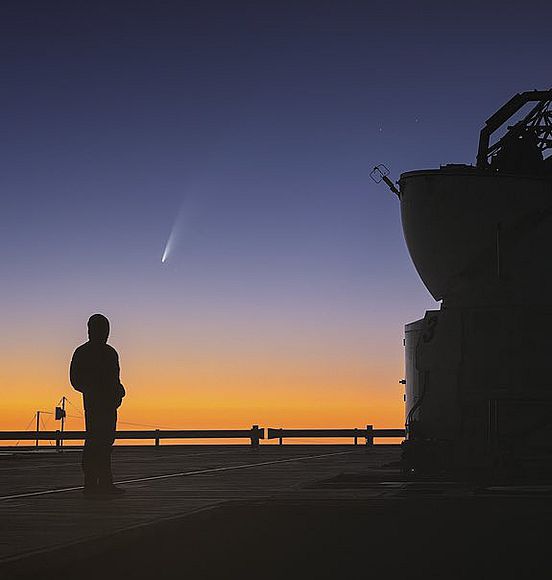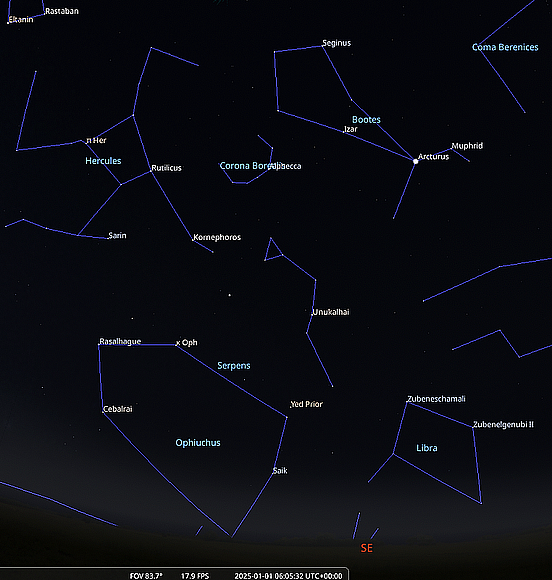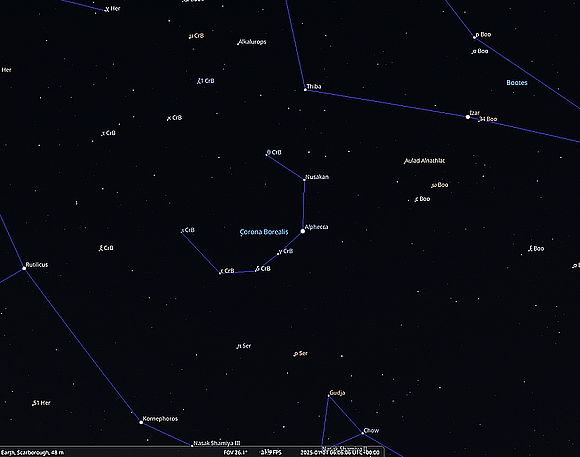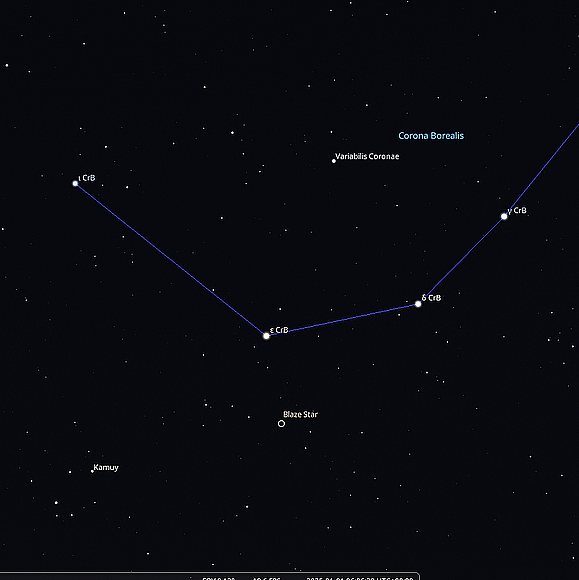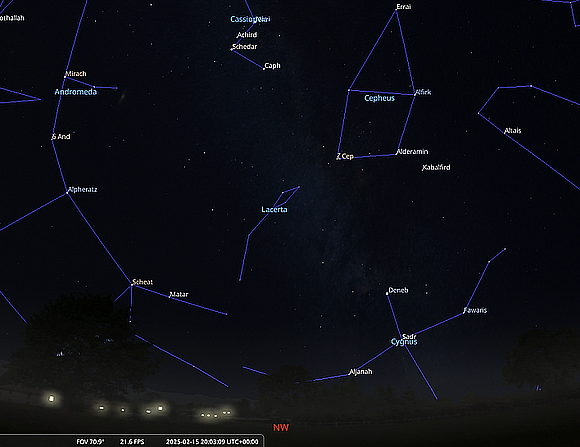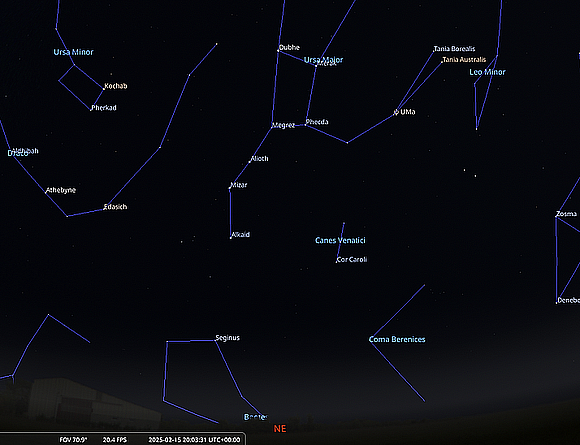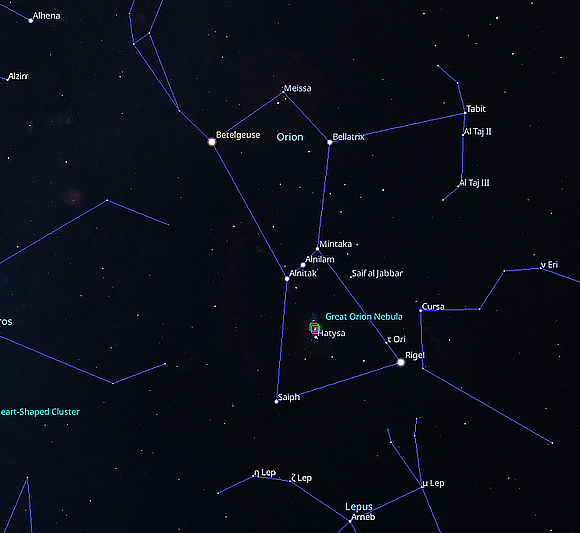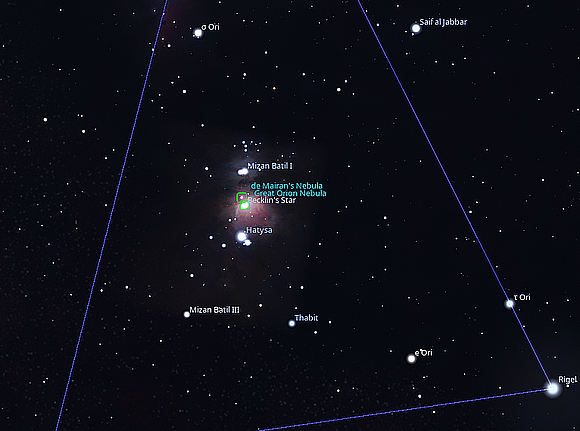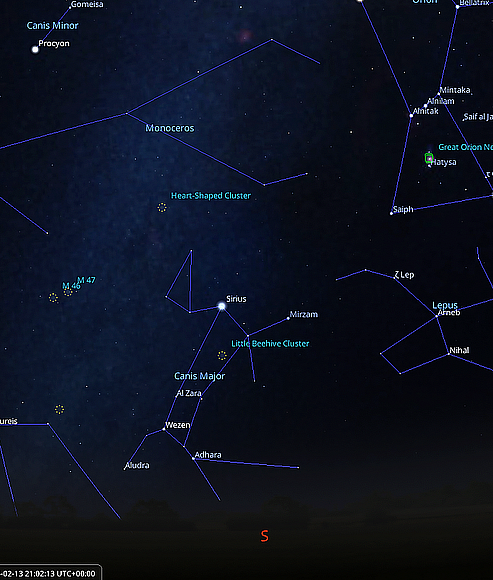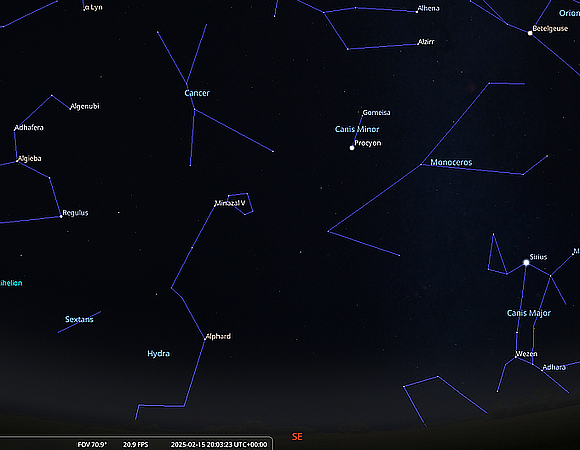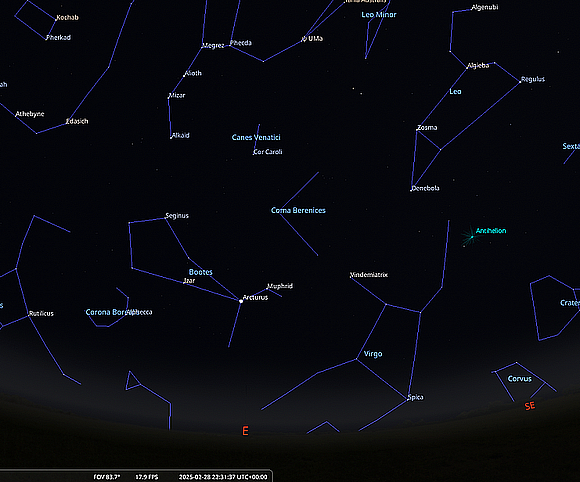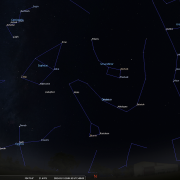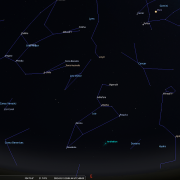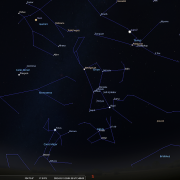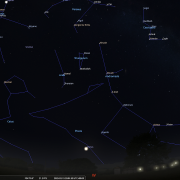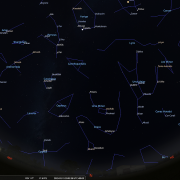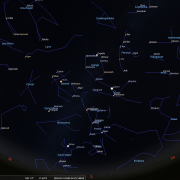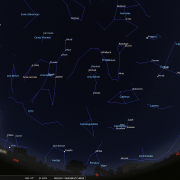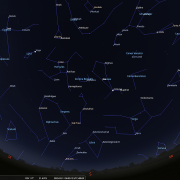In this month's Sky Notes:
- Planetary Skylights.
- February Meteors, Comet Atlas 2024 G3, T CorB.
- February Night Sky.
- February 2025 Sky Charts.
Planetary Skylights - Brief
Venus dazzles in the evening sky, while Jupiter is visible overnight. Mars has a close conjunction with the Moon in the UK. Saturn and Neptune fade into twilight by the month's end. Uranus can be observed with a telescope, and Mercury appears in the west evening twilight near the end of the month.
 Venus continues to be prominent in the evening sky and will remain visible until after 21:00 GMT mid-February from the UK. During evening twilight, Venus is positioned approximately 35 degrees above the southwest horizon, although its altitude will gradually decrease as the month progresses. On February 14th, Valentines Day in the UK, the goddess of beauty - Venus will reach its peak brilliance with a magnitude of -4.64, bright enough to cast a very faint shadow.
Venus continues to be prominent in the evening sky and will remain visible until after 21:00 GMT mid-February from the UK. During evening twilight, Venus is positioned approximately 35 degrees above the southwest horizon, although its altitude will gradually decrease as the month progresses. On February 14th, Valentines Day in the UK, the goddess of beauty - Venus will reach its peak brilliance with a magnitude of -4.64, bright enough to cast a very faint shadow.
As Venus approaches Earth in its orbit, it will be just 0.34 AU away by the end of the month. The apparent size of Venus’s disk will increase from 32 arcseconds to nearly 49 arcseconds by month's end, while the phase illumination will decrease from 38% to a crescent of just under 15% over the same period. It is advisable to view Venus through a telescope during twilight to avoid the glare that can occur when observing it in a darker sky. Additionally, the Moon will be located below Venus on February 1st and above it on February 2nd.
 Saturn is approaching the end of its current apparition, moving toward the WSW horizon. It's visible only in early February, disappearing into evening twilight by month's end. Through a telescope, the rings appear closed but not edge-on and will remain so when Saturn reappears in the morning sky in late spring. On the first evening of February, Saturn is below the crescent Moon at twilight (around 18:00 hrs), both located below bright Venus in the SW.
Saturn is approaching the end of its current apparition, moving toward the WSW horizon. It's visible only in early February, disappearing into evening twilight by month's end. Through a telescope, the rings appear closed but not edge-on and will remain so when Saturn reappears in the morning sky in late spring. On the first evening of February, Saturn is below the crescent Moon at twilight (around 18:00 hrs), both located below bright Venus in the SW.
Before Saturn finally departs it has one more planetary conjunction, this one with Mercury. It will be challenging to view being just a few degrees above the WSW horizon, so a flat horizon is a must. View around 18:15hrs, Mercury will be the brighter of the pairing, right of Saturn. Binoculars will assist in spotting them.
If the evening of February 24th is clear and Saturn is visible above the west-southwest horizon near Mercury, direct a telescope toward Saturn. Although the view may not be optimal, there is an opportunity to observe the shadow transit of its major moon, Titan, which will appear as a black dot on the disk. It is crucial to conduct this observation between 18:00 and 18:15 GMT. Best of luck with your observations.
A close up view of the shadow transit of Titan on Feb 24th at 18:05hrs. (Click to view how the image may look in a 125mm aperture scope -5" at medium power)
 Jupiter is the most conspicuous planetary presence in the night sky following the departure of Venus around 21:00hrs. At magnitude -2.4 it far 'outshines' any star in the winter sky. Located in Taurus the Bull above its chief star, fiery Aldebaran set amongst the Hyades star cluster, Jupiter has ceased its retrograde motion and appears stationary for a few days at the start of February before commencing its normal prograde motion, eastwards. Culminating an impressive 60-degrees in altitude, Jupiter has a very healthy 7 hour plus observing window in which to fully scrutinise the Jovian system, one that offers up interest to scopes of any aperture size.
Jupiter is the most conspicuous planetary presence in the night sky following the departure of Venus around 21:00hrs. At magnitude -2.4 it far 'outshines' any star in the winter sky. Located in Taurus the Bull above its chief star, fiery Aldebaran set amongst the Hyades star cluster, Jupiter has ceased its retrograde motion and appears stationary for a few days at the start of February before commencing its normal prograde motion, eastwards. Culminating an impressive 60-degrees in altitude, Jupiter has a very healthy 7 hour plus observing window in which to fully scrutinise the Jovian system, one that offers up interest to scopes of any aperture size.
Jupiter's bright oblate disk some 41 arc seconds in diameter is a fine spectacle through the eyepiece, flanked as it is by the Galilean moons. The dark equatorial belts should be readily visible in instruments as small as 60mm (2.5”) aperture, larger instruments revealing the more subtle, and finer northern and southern temperate belts.
When orientated in our direction look for the great red spot (GRS) the seemingly ever-present colossal storm system, which over the last four decades has diminished in size by a third, and hue intensity. The GRS can be observed in 100mm (4”) scopes but will be more obvious with 150mm (6”) instruments at medium powers. Look for the GRS on Feb 1st, 4th, 6th, 11th, 16th, 18th, 21st, 23rd and 28th between 19:00hrs and 22:00hrs GMT.
The planetary sized Galilean moons orbiting around Jupiter do so in different time periods just like a mini solar system. Regular observers of the Jovian system will be familiar with this 'dance' of Io, Europa, Ganymede, and Callisto around Jupiter, throwing up a different configuration each night. From time-to-time shadow transits occur (visible as black dots transiting the disk of Jupiter) and are particularly fascinating to view.
A minimum aperture of 100mm (4") with high magnification should suffice to spot the shadow transit, but the satellites themselves are more challenging to spot requiring larger apertures. The most favourable evening shadow transits in February are Io - Feb 3rd @ 20:00hrs, Europa - Feb 18th @ 20:00hrs and Ganymede - Feb 25th @ 20:00hrs GMT.
 Mars continues to be a prominent feature in the night sky following its opposition in mid-January. In early February, Mars has a magnitude of -0.9, making it the third brightest planet visible at twilight, after Venus and Jupiter. However, by the end of the month, its brightness will decrease to a magnitude of -0.36.
Mars continues to be a prominent feature in the night sky following its opposition in mid-January. In early February, Mars has a magnitude of -0.9, making it the third brightest planet visible at twilight, after Venus and Jupiter. However, by the end of the month, its brightness will decrease to a magnitude of -0.36.
For UK observers, Mars is optimally positioned high in the winter sky within the heart of Gemini, maintaining a relatively fixed position throughout the month. Due to its elevated position, Mars will remain above the 25-degree elevation mark for over seven hours each night, below which poor seeing conditions can degrade image quality. While Mars appears bright to the naked eye, its disk size in the eyepiece is comparatively small, decreasing from nearly 14 arc-seconds in diameter at the beginning of February to less than 11 arc-seconds by the end of the month.
Through the eyepiece, Mars will show its rusty orange colour. With a telescope over 100mm (4"), you can see darker markings at medium/high powers. Avoid pushing the power too much to maintain brightness and clarity. Look for the 'V wedge' of Syrtis Major from the 17th to 25th and try to spot the northern polar cap.
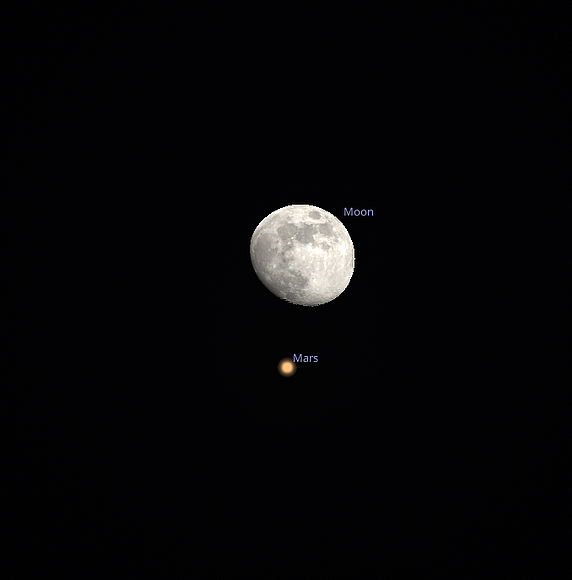 Conjunction of Moon and Mars - Feb 9th at 18:00hrs GMT. Binocular view.
Conjunction of Moon and Mars - Feb 9th at 18:00hrs GMT. Binocular view.
The highlight of the month is on February 9th, when Mars and the Moon have a close encounter. You can watch the conjunction unfold in a few hours. Look ESE around 18:00hrs to see Mars below the Moon.
Feb 9th. Mars - Moon conjunction at closest - 18:55hrs - just over 3 arc-minutes.
(Click for larger image)
By 18:55hrs the pair are at their closest with Mars just over 3 arc-minutes lower right of lunar limb.
Telescope view @ medium/high power of Moon - Mars conjunction around 18:55hrs.
(Click for full image)
By 20:00hrs, the Moon will have moved to the left of Mars. Enjoy the view through binoculars, a telescope, or with the naked eye.
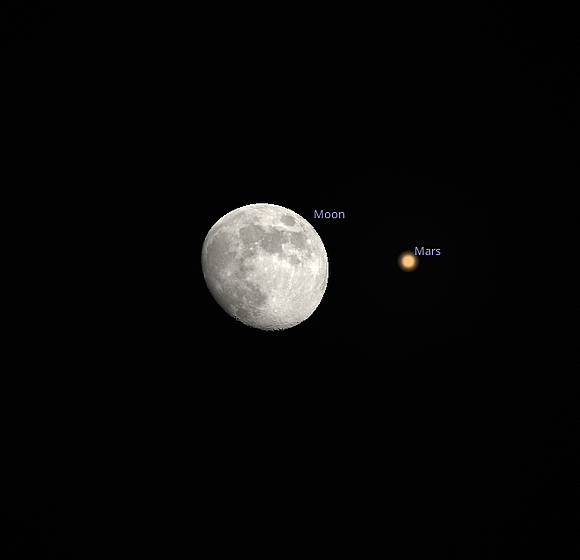
 Uranus is well positioned for observation in the mid-evening sky, located approximately 8-degrees lower right of the Pleiades star cluster in Taurus the Bull, but actually lies just over the border in the neighbouring constellation of Aries. Although possible to spot with the naked eye, Uranus realistically requires binoculars to identify it as a magnitude +5.8 'faint star'. Apertures of 80mm and above (3"+) will reveal the very small 3.7-degree grey-green disk, whilst instruments of 150mm and above (6") are necessary to resolve it definitively. Delta Ari or Botein, 3 degrees to the right of Uranus, is at magnitude +4.4 the nearest naked eye star to it.
Uranus is well positioned for observation in the mid-evening sky, located approximately 8-degrees lower right of the Pleiades star cluster in Taurus the Bull, but actually lies just over the border in the neighbouring constellation of Aries. Although possible to spot with the naked eye, Uranus realistically requires binoculars to identify it as a magnitude +5.8 'faint star'. Apertures of 80mm and above (3"+) will reveal the very small 3.7-degree grey-green disk, whilst instruments of 150mm and above (6") are necessary to resolve it definitively. Delta Ari or Botein, 3 degrees to the right of Uranus, is at magnitude +4.4 the nearest naked eye star to it.
 Neptune remains visible above the horizon throughout most of February; however, it will become increasingly difficult to observe from mid-month onwards as twilight and low altitude affect its visibility. The faint planet sets around 19:30 GMT in the UK. Neptune is located approximately 13 degrees to the upper left of Saturn, beneath the faint loop of stars that delineate the western fish of Pisces, specifically lambda Piscium (magnitude 4.5). The nearest notable stars are the chain of 5th magnitude stars 20, 24, 27, and 29 Piscium, situated about a degree to the left of Neptune.
Neptune remains visible above the horizon throughout most of February; however, it will become increasingly difficult to observe from mid-month onwards as twilight and low altitude affect its visibility. The faint planet sets around 19:30 GMT in the UK. Neptune is located approximately 13 degrees to the upper left of Saturn, beneath the faint loop of stars that delineate the western fish of Pisces, specifically lambda Piscium (magnitude 4.5). The nearest notable stars are the chain of 5th magnitude stars 20, 24, 27, and 29 Piscium, situated about a degree to the left of Neptune.
Neptune itself shines at an 8th magnitude, appearing as a small 2.4 arc-second disc through a telescope eyepiece. Observers will require a minimum aperture of 100mm (4 inches) with 100x magnification, along with good viewing conditions to discern this, although a larger aperture would be more advantageous for better definition. If conditions permit, one can look for Neptune on the evening of February 1st (around 18:45 GMT) when Venus will be situated to its upper right, and a very slim crescent Moon will be to its lower right.
 Mercury commences an evening apparition towards the end of February, rising swiftly from the west-southwest horizon from February 22nd onwards. It can initially be observed at approximately 18:00hrs, about 40 minutes after sunset. With a magnitude of -1.26, Mercury is bright; however, twilight and its very low altitude may reduce its visibility, but it should be readily discernible with binoculars. By February 24th, Mercury is in conjunction with Saturn, appearing to the right of Saturn and slightly above it on the 25th at 18:15hrs. As with all evening apparitions, Mercury appears brightest at the beginning but is low. As it gains in elevation it will gradually diminish in brightness but is still a respectable 1st. magnitude object as the apparition extends into March.
Mercury commences an evening apparition towards the end of February, rising swiftly from the west-southwest horizon from February 22nd onwards. It can initially be observed at approximately 18:00hrs, about 40 minutes after sunset. With a magnitude of -1.26, Mercury is bright; however, twilight and its very low altitude may reduce its visibility, but it should be readily discernible with binoculars. By February 24th, Mercury is in conjunction with Saturn, appearing to the right of Saturn and slightly above it on the 25th at 18:15hrs. As with all evening apparitions, Mercury appears brightest at the beginning but is low. As it gains in elevation it will gradually diminish in brightness but is still a respectable 1st. magnitude object as the apparition extends into March.
Mercury and Saturn conjunction Feb 25th @ 18:15hrs a few degrees above WSW horizon.
(Click for full image)
February Meteors
February has no notable meteor showers. The Alpha Aurigids, peaking in mid-January to mid-February, are minor with only 2-5 meteors per hour. Despite this, meteors during this time are often bright. The period from late January to March is known as the 'fireball season' and may be remnants of an old, depleted shower similar to the Geminids, the meteoroids being denser in nature. If you see a meteor from Auriga, note it; otherwise, it's likely just sporadic.
Comet C/2024 G3 (ATLAS)
Predictions that comet Atlas C/2024 G3 could potentially be the brightest comet of 2025 may turn out to be correct, at least for southern hemisphere observers, becoming one of only 4 comets on record to become bright enough to be visible in the daytime without optical aid. Observers in equatorial latitudes, along with spacebourne satellites data report C/2024 G3 may have reached magnitude -3.7, almost as bright as Venus.
Comet Atlas C/2024 G3 imaged on Jan 19th from Australia. Image photo credit - Blake Estes.
(Click for full size)
Discovered in April 2024 by the automated (ATLAS) system, this sungrazer comet made a close perihelion passage around the Sun, at 13.5 million kilometres (8.5 million miles) on January 13th. Astronomers were uncertain about the comet's survival during this close passage, as sungrazers often disintegrate but can become very bright if they do so. Current observations indicate that 2024 G3 did survive for some time, although recent reports suggest the head disintegrated, leaving only the tail. The comet had an orbital period of over 160,000 years, which may now be up to 600,000 years due to changes in its orbital path.
Comet Atlas C/2024 G3 imaged from near Paranal Observatory, Chile on Jan 18th.
Image photo credit: Yuri Beletsky. (Click for larger image)
Observers in the Northern Hemisphere, particularly those from temperate latitudes such as the UK, were unable to witness the celestial event. Despite predominantly clear evenings over the mid-January period, the comet was not sufficiently bright to penetrate the twilight at its very low altitude of visibility. Whereas from more ‘southerly’ northern latitudes and the southern hemisphere the comet appeared bright enough to provide a spectacular display. Frustratingly then the situation presented a near-miss situation for ‘us’ northern observers, not unlike comet McNaught in 2007.
Comet Atlas C/2024 G3 imaged at the Paranal Observatory, Chile.
Image photo credit: Yuri Beletsky. (Click for larger image)
T Corona Borealis.
Astronomers are still awaiting T Coronae Borealis (T CrB), nicknamed the Blaze Star, to go Nova. Located in the constellation Corona Borealis, this 10th magnitude binary star and recurrent nova flares up to 2nd magnitude roughly every 80 years and is due to do so again this year.
General location chart for Corona and Boötes in morning sky around 05:00hrs GMT.
(Click for full image)
T CrB is closely monitored with tell-tale signs in brightness fluctuations leading astronomers to conclude a nova outburst is imminent. The Blaze star is located just below the circlet of stars making up Corona Borealis which resides left of the constellation Boötes highlighted by brilliant orange Arcturus. T CrB is normally only visible in large binoculars or a telescope.
Currently Corona does not become visible until the midnight hour, although by the end of February it will be on show low to NE by 21:30hrs. Keep tabs across the media and internet, but ignore any sensational reports of it becoming a brilliant object lighting up the sky - it is not a supernova, just a nova, but the nature of the outburst is still impressive, it’s not every day we get to observe a star suddenly brighten. See January Sky Notes for full details on T CrB.
February Night Sky
Winter's darkest days are now fading as daylight hours grow longer and with Meteorological Spring starting in March, hinting at milder weather ahead we could be forgiven in thinking winter has done with us. Astronomical spring does not start until March 21st and winter might still surprise us. Currently, the night sky still reflects mid-winter, with corresponding constellations prominent. February skies are particularly majestic, enticing observers to explore further.
At the start of the month the western aspect of the early evening sky is still dominated by autumnal constellations, particularly the great square of Pegasus. Sprouting off the winged horse, the stars of Andromeda reach up to the figures of Perseus and distinctive Cassiopeia - departing the zenith overhead. Circumpolar Summer stars are banished to the margins low to the north, Vega and Deneb in Lyra and Cygnus respectively flirting with the horizon. These circumpolar 'summer triangle' luminaries will endure the winter nights, not seeking warmer climes like their brethren member Altair, now long departed.
Seemingly stood on its tail, the stars of the familiar Plough asterism identify the hind quarters of the Great Bear. Utilise the 'pointer stars' in the bowl of the Plough, Dubhe, and Merek to track down the Pole star, Polaris in the constellation of Ursa Minor located to the left of the Plough. The Celestial dragon – Draco winds between the two bears due North, the head of the beast marked by an irregular quadrilateral of stars upper right of Vega. Overhead the distinctive ‘W’ pattern of Queen Cassiopeia first occupies the zenith, followed by Perseus (the outline of which resemble a distorted figure Pi symbol) and then the stars of Auriga the charioteer, highlighted by brilliant Capella.
To the south ranged across the sky the majestic stellar canopy attracts the eye. Here the observer is treated to an array of imposing constellations, brilliant stars, and observational interest. At the head of this wondrous stellar cavalcade sit the distinctive 'V' pattern of the Hyades - the head of the Bull - Taurus. The open cluster contains the marmalade hue of Aldebaran, 'the eye of the bull’, however the lead star in Taurus is not a genuine member residing 60 light years away, half the distance of the true Hyades members.
Further west of the Hyades, the Pleiades star cluster (Seven Sisters) is a beautiful sight in binoculars or low power eyepiece. It is one of the most youthful clusters by stellar standards (150 million years), comprised of many hot, massive B class stars. Keen sighted observers can make out more than seven stars with the naked eye, although most people see six. Binoculars, or very low telescopic magnifications, reveal dozens of stars and the entire cluster contains over 360 members approximately 410 light years away.
By mid-evening, the focal point of the seasonal winter sky, the mighty hunter Orion, stands proud due South, the heart of the glittering tableau ranged around it. Observable from every inhabited place on Earth, the outline of the hunter is quite distinct; the three belt stars set betwixt a larger rectangle, two of these stars in the 'box', in opposing corners are genuine super luminaries’. Rigel illuminates the bottom right of the rectangle, a B7 class blue/white star at least 60,000 times more luminous than our Sun.
The top left corner is marked by the fiery hue of Betelgeuse, a red super-giant star of gargantuan proportions, over 400 million miles in diameter with one foot in the stellar grave. Betelgeuse is considered the strongest stellar supernova candidate, perhaps within the next 10-20 thousand years. Recent fluctuations in Betelgeuse’s brightness perhaps an indication of the star’s initial behaviour towards its cataclysmic fate. Rigel is also massive enough to end its days as a supernova, tens of millions of years in the future, short by stellar standards.
Situated just beneath the three stars marking Orion’s belt resides one of the great show piece objects in the night sky, the Orion nebula, the closest region of star formation to us, around 1300 light years. The Nebula, which is thought to be less than 2.4 million years old, consists of a huge cloud of gas and dust around 25 light years in extent. Within the densest clumps of gas, stellar formation is underway, unseen by optical observation.
Seen clearly as a misty smudge through smaller binoculars, telescopically, or with very large binoculars the Orion nebula is quite a breathtaking sight, a swirl of nebulous cloud at the heart of which reside a trapezoid-shaped asterism from which the cluster gets its name, the Trapezium, the four “bully boys” of this stellar crèche. The brightest members are found within 1.5 light years of each other and have estimated solar masses of between 15 and 30 times our Sun. These young OB stars are luminous X-ray sources and are responsible for much of the illumination of the surrounding nebula. The powerful UV radiation force from these stars has hollowed out a cavity in the nebula several light years across, allowing us to see the trapezium stars. It is thought many of the stars forming in the cluster are no more than 300,000 years old, with the brightest as young as 10,000 years. The Trapezium stars are easily seen with modest telescopes, even large binoculars will reveal them.
Upper left of Orion stands the Twins of Gemini, marked by the two conspicuous stars, Castor, and Pollux. Castor, the most northerly of the pair, is slightly fainter than twin brother Pollux which shines with a pale amber lustre. Although Castor appears solitary, it is a multiple system of which the brightest two components may be separated in a modest scope, given stable atmospheric conditions. Gemini is home to the fine open cluster M35, sometimes known as the shoe-buckle cluster.
The two hunting dogs of Orion, Canis Major, and Canis Minor, dutifully follow their master across the heavens. The belt stars of Orion point down in the general direction of Canis Major and the most prominent of all night stars, sparkling Sirius, seen low to the SSE. Some distance above and left, solitary Procyon, in the lesser dog of Canis Minor, is yet another highly conspicuous winter jewel, the prominence of both stars primarily due to proximity; 8.6 and 11 light years respectively. Both stars have companion white dwarf stars, though they are very difficult to spot even with quite large instruments.
Look for the faint glow of the winter Milky Way which flows to the left of Orion, separating the two dogs on opposing banks. The dogs' quarry, the timid celestial hare of Lepus, may be traced crouching below Orion and above the southern horizon. Lepus contains one Messier object, M79, a distant globular cluster. Within the faint starry haze left of Orion, a more modern constellation is located, the heavenly unicorn of Monoceros. Its stars are faint and to the naked eye the area looks bland but hidden just beyond our gaze reside a multitude of star clusters and nebulae.
Below the Unicorn, Puppis, part of the now defunct constellation of Argo Navis straddles the S horizon. It too is rich in galactic clusters and nebulae, including the Messier objects M46, M47 and M93. The longest constellation in the heavens (or at least a section of it) occupies much of the sky lower right of Orion. The river Eridanus, the source of which rises just to the right of Rigel, marked by Cursa or beta Eridani, then flows erratically parallel to the southern horizon before plunging through it, journeying far down into the southern hemisphere, ending at a brilliant star called Archenar.
Toward the back end of February, night finds Orion and his entourage already trooping into the west half of the sky, their places taken by an ensemble of spring constellations. The inconspicuous stars of Cancer scuttle after Gemini and mark the border of seasonal change from winter to spring. Leo the lion follows, identified by the distinctive ‘Sickle’ asterism, at the foot of which shines bright Regulus. The faint, but distinctive knot of stars marking the head of Hydra hang above the Water Snakes chief star, Alphard - the "Lonely one", lower left of Procyon. The clock will already have struck midnight before the rest of the serpent slithers fully into view.
Post midnight, the brilliant amber hue of Arcturus in Boötes and pearly Spica in Virgo, join the victims of Hercules, itself only just clearing the ENE horizon. All constellations associated with spring and early summer and already pushing the stars of winters tableau toward the western door.
The return of spring skies - sprouting from the east. End of February - 22:30hrs.
(Click for full image)
February 2025 Sky Charts
Additional Image Credits:
- Planets and Comets where not otherwise mentioned: NASA
- Sky Charts: Stellarium Software and Starry Night Pro Plus 8
- Log in to post comments

